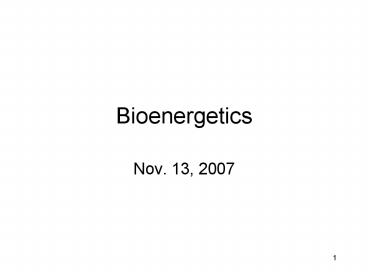Bioenergetics
1 / 29
Title: Bioenergetics
1
Bioenergetics
- Nov. 13, 2007
2
Outline
- Quick review of Week 6
- Bioenergetics
- Thermodynamics
- Show me the money! ATP
- Biological phosphate compounds
- Coupled rxns
- Biological redox rxns
3
Week 6 Quick Review
- Enzyme regulation
- Why it is necessary
- Inhibitors
- Allosteric Enzymes
- Metabolic pathways
- Metabolites, characteristics, anabolic,
catabolic, localization of pathways
4
I am so Intrigued by metabolism. Please tell
me more.
5
Bioenergetics
- The study of how organisms manage their energy
resources
6
Cells require sources of free energy
- Heat flow is not an energy source for cells
- Cells use free energy (G)
- Gibbs free-energy
- Helps us predict direction of rxn
- Helps us predict equilibrium position
7
Recall
- Rxn will proceed A--gtB only if Gibbs Free Energy
of B is lower than that of A - Catalysis does not influence thermodynamics
- ?G? GB? - GA ?
8
Recall
- GA GA? RT ln A
- ?G(A--gtB) ?G?(A--gtB) RT ln B/A
- R 8.31 x 10-3 kJ/(K mol)
- Standard T 298 K
- ln B/A 2.3 log B/A
- At equilibrium, ?G 0 and B/A Keq
- 0 ?Gº RT ln Keq
- ?Gº(A--gtB) -RT ln Keq
9
?Gº(A--gtB) -RT ln Keq
- Biochemical standard free energy change (?Gº) of
a chemical rxn is simply an alternative way of
expressing an equilibrium constant (Keq) - Actual free-energy changes (?G) depend on
reactant and product
10
Note the following
- ?G(A--gtB) ?G?(A--gtB) RT ln B/A
- ?Gº(A--gtB) -RT ln Keq
- The sign of ?Gº or ?G indicates direction of rxn
- Magnitude of ?Gº or ?G is proportional to how
far rxn can proceed before reaching equilibrium - ?Gº and ?G are independent of rxn pathway
- ?Gº and ?G of coupled rxns are additive
- ?GA--gtB -?GB--gtA
11
Table 1. Thermodynamic Relationships
12
Cellular reactions need to be thermodynamically
favorable
- A ----gt B
- Lets consider three different cellular
situations - ?GºA--gtB ltltlt 0
- ?GºA--gtB gt 0 or ?GºA--gtB lt 0
- ?GºA--gtB gtgtgt 0
13
?GºA--gtB ltltlt 0
- ATP hydrolysis
- ATP H2O --gt ADP Pi ?Gº -30.5 kJ/mol
- ?Gº -RT lnKeq
- ln Keq -30.5 kJ/mol (-K mol/0.0083 kJ) (298
K)-1 - ln Keq 12.3, Keq 2.2 x 105
- What does this mean?
- ADPPi/ATP 220,000 at eq.
14
?GºA--gtB gt 0, or ?GºA--gtB lt 0
- Glucose-6-P lt-----gt Glucose-1-P
- Keq 1/19
- ?Gº -RT lnKeq
- ?Gº (-0.00831 kJ/K mol)(298 K) x ln(1/19)
- ?Gº 7.3 kJ/mol
- What does this mean?
- What if the actual cellular B and/or A are
different? - ?G(A--gtB) ?G?(A--gtB) RT ln B/A
15
What if the actual cellular Glucose-6-P and
Glucose-1-P are different?
- Glucose-6-P 0.199 M
- Glucose-1-P 0.001 M
- ?G(A--gtB) ?G?(A--gtB) RT ln B/A
- ?G 7.3 kJ/mol (0.00831 kJ/K mol)(298 K) x
ln(0.001/0.199) - ?G -5.8 kJ/mol
16
Standard free-energy change
- What does it tell us?
- Tells us
- The direction for a given rxn
- How far the rxn must go to reach equil.
- Applies when initial concentration of each
component is 1.0 M, pH 7.0, 298 K, 1 atm - It is constant
17
?G?(A--gtB) gtgtgt 0 Figure 16-21a
Page 567
18
exergonic vs exothermic endergonic vs endothermic
- -gonic is a broader term and refers to free
energy - -thermic refers to heat energy
19
In other words
- A ----gt B ?Gº1
- B ----gtC ?Gº2
- Sum A----gtC ?Gº1 ?Gº2
20
Show me the money!
Thats nice and all, but Show me the money!
21
Figure 16-20 ATP is energy currency
Page 566
22
The free-energy change for ATP hydrolysis is
large and negative
- chemical energy is donated to endergonic rxns
- Synthesis
- Transport
- Mechanical motion
- Dont confuse bond energy for high-energy bonds
23
Why are the phosphoryl transfer rxns of ATP so
exergonic?
- ATP ---gt ADP Pi
- Hydrolysis
- Separates negatively charged phosphates
- Relieves electrostatic repulsion
- Pi (HPO42-) orthophosphate is resonance
stabilized - ADP2- ionizes
24
ATP Hydrolysis
25
Actual free-energy change for ATP Hydrolysis
26
Keeping it real The real cost of doing metabolic
business
- Phosphporylation potential (?Gp) is the cellular
?G for ATP hydrolysis - Calculate the the ?Gp in human erythrocytes.
Assume ATP, ADP, and Pi are 2.25, 0.25, and 1.65
mM, respectively. The pH is 7.0 and the
temperature is 25 ºC.
27
- Calculate the the ?Gp in human erythrocytes.
Assume ATP, ADP, and Pi are 2.25, 0.25, and 1.65
mM, respectively. The pH is 7.0 and the
temperature is 25 ºC. - ?Gp ?Gº RT ln ADPPi/ATP
- ?Gp -30,500 J/mol (8.315 J/ mol K)(298 K) x
ln (2.50 x 10-4)(1.65 x 10-3)/(2.25 x 10-3) - ?Gp -51.8 kJ/mol
28
ATP Provides Energy by Group Transfers, not by
Simple Hydrolysis
- ATP ---gt ADP Pi
- ATP hydrolysis generates heat
- In reality, ATP participates covalently in an
enzyme catalyzed rxn
29
Figure 16-25 modified
Page 569































